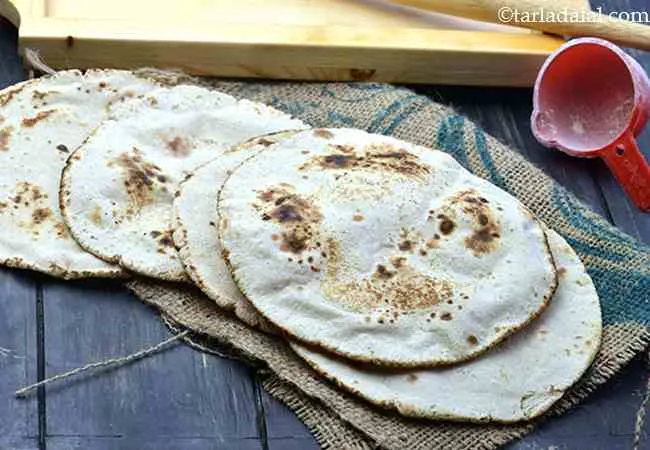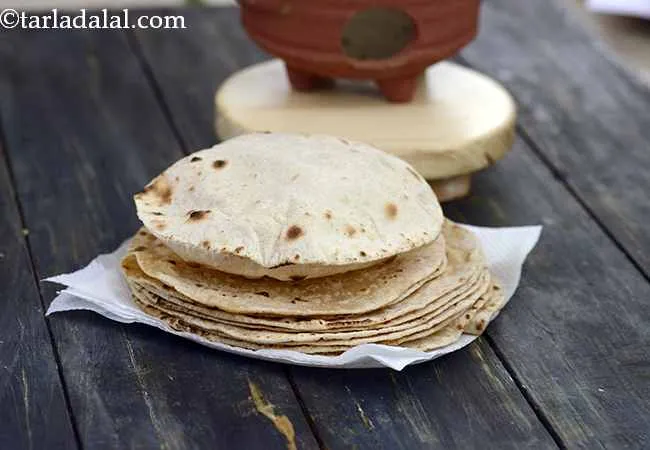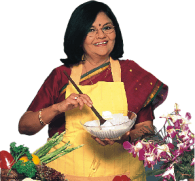Calories in Vegetable Kolhapuri Recipe
This calorie page has been viewed 9222 times

Table of Content
How many calories does one serving of Vegetable Kolhapuri, Maharashtrain Vegetable Kolhapuri have?
One serving of Vegetable Kolhapuri, Maharashtrain Vegetable Kolhapuri gives 205 calories. Out of which carbohydrates comprise 60 calories, proteins account for 18 calories and remaining calories come from fat which is 128 calories. One serving of Vegetable Kolhapuri, Maharashtrain Vegetable Kolhapuri provides about 10 percent of the total daily calorie requirement of a standard adult diet of 2,000 calories.
Click here to see Vegetable Kolhapuri, Maharashtrain Vegetable Kolhapuri calories. Vegetable Kolhapuri is a traditional vegetable dish prepared in Maharashtrian style. In fact, it is the masala paste made with coconut, red chillies, sesame seeds and other ingredients that gives it the title of Kolhapuri!
The paste gives the veggies a very strong flavour, thanks to sesame and garlic, and a richness that is characteristic of coconut and poppy seeds.
Put together tangy tomatoes, crunchy onions and a basketful of colourful veggies with this masala and you get a tongue-tickling delicacy that is hard to resist.
Serve this authentic dish with traditional Maharashtrian breads like Chawal Bhakri and Jowar Bhakri , to make a hearty meal.
Jowar Bhakri, Healthy Jowar Bhakri
Is Vegetable Kolhapuri, Maharashtrain Vegetable Kolhapuri healthy?
Yes, this is healthy. But restrictions apply .
Lets understand the ingredients of Vegetable Kolhapuri, Maharashtrain Vegetable Kolhapuri.
What's good in this Vegetable Kolhapuri, Maharashtrain Vegetable Kolhapuri recipes!
French Beans ( Fansi ) : French Beans is rich in folic acid. A deficiency of folic acid can also lead to anaemia, as like iron they are equally necessary to make red blood cells. Without enough folic acid, you can get easily tired. Pregnant women can also benefit from its folic acid count. It’s effective to achieve weight loss, overcome constipation, control blood sugar levels, treat high cholesterol as well as prevent cancer. See here for detailed 15 benefits of french beans.
Carrots (gajjar) : Carrots have the nutrient Beta Carotene which is a form of Vitamin A, helps prevent deterioration of the eye as one gets older and prevents night blindness. Carrot is great for the eyes.They relieve constipation, lower blood pressure, have fibre and lower cholesterol. Read the 11 super benefiits of carrots and why to include in your daily diet.
Green Peas : Green peas are good for weight loss, good source of vegetarian protein, has insoluble fibre to relieve constipation. Legumes like green peas, cow peas, mung, chick peas and kidney beans have a cholesterol lowering effect. Green Peas are rich in Vitamin K which aids in bone metabolism. Green peas have a Glycemic Index (GI) rank of 22 which is low and good for diabetics. Is green peas good for diabetics and see full benefits of green peas.
Onions (pyaz, kanda) : Raw onions are a very valuable source of vitamin C – the immune building vitamin. Along with other phytonutrients from onions, it helps to build WBC (white blood cells) which serves as a line of defence against illness. Yes, it’s a source of many antioxidants, the most important one amongst them being Quercetin. The quercetin in Onions promotes production of HDL (good cholesterol) and lowers total cholesterol in the body. The sulphur in onions act as a blood thinner and prevents blood clotting too. This in turn would lower blood pressure and good for heart, diabetics. Read the benefits of onions.
Tomatoes : Tomatoes are extremely rich source of Lycopene. Tomatoes are a powerful antioxidant, super rich in Vitamin C, good for heart. Tomatoes are a Pregnant women's friend and are rich in Folate or Folic Acid which helps your body to produce and maintain new cells, especially red blood cells. Read about 13 amazing benefits of tomatoes.
Coriander (kothmir, dhania) : Coriander is a fresh herb often used as a flavour enhancer in Indian cooking. It is mainly used as a garnish. This is the best way to use it - no cooking. This preserves its vitamin C content which helps to build our immunity and bring that sparkle to the skin. The antioxidants vitamin A, vitamin C and the quercetin present in coriander works towards strengthening our immune system. Coriander is a fairly good source of iron and folate – the 2 nutrient which help in the production and maintenance of red blood cells in our blood. Good for reducing cholesterol and good for diabetics. Read 9 benefits of coriander to understand details.
Dry Coconut : The dry coconut has saturated fats but most of it is MCT (Medium Chain Triglycerides) which promote weight loss. The high fibre content 13.6 gm (45.3% of RDA) along with high lauric acid content of coconut improves cholesterol levels in the body. Improving the action of insulin secretion and lowering the raised blood sugar levels is yet another benefit of coconut for Diabetics. See here for 10 amazing benefits of coconut.
Garlic : Garlic has been proven to lower cholesterol. The active ingredient allicin present in garlic aids in lowering blood pressure. Garlic is also alleged to help regulate blood glucose levels for diabetics. Garlic is great for the heart and circulatory system. Garlic has an antimicrobial, antiviral and antifungal function and can help in relieving common cold and other viral infections. To boost your immune system have a garlic clove a day. Garlic is a top anti viral food. The thiosulphate compound, Allicin found in garlic acts as a strong antioxidant and protects our body from damage of free radicals. Read here for complete benefits of garlic.
Sesame Seeds (Til) : These tiny white seeds are indeed a good source of protein. Half of daily requirement of calcium is fulfilled by consuming ½ cup of sesame seeds. Sesame seeds are a storehouse of iron, folic acid and help to prevent iron deficiency anaemia and boost your energy. The lignans, a type of polyphenol, present in seed does wonders to naturally reduce cholesterol levels. See detailed benefits of sesame seeds.
What's problem in this Vegetable Kolhapuri, Maharashtrain Vegetable Kolhapuri subzi.
Vegetable Oils : To some vegetable oil is only soyabean oil, while some promote it as a mix of oils like soyabean, canola, sunflower, corn and other omega-6 rich oils. These are often cheaper options than many oils, but they are highly processed oils. They are undoubtedly not to be reached out for, whether you are looking for salad dressings, sautéing or cooking. The 5 best oils used in cooking are olive oil (low temperature short time cooking), avocado oil, canola oil, coconut oil and peanut oil. You must read the super article to find the facts of which oil is the healthiest avoid vegetable oil.
What is the healthy accompaingment for Vegetable Kolhapuri, Maharashtrain Vegetable Kolhapuri?
We suggest a bajra roti, jowar roti, radish nachni roti recipe , basic ragi roti recipe, and whole wheat roti to make a healthy combination.
Can diabetics, heart patients and over weight individuals have Vegetable Kolhapuri, Maharashtrain Vegetable Kolhapuri?
Yes, this recipe is a suitable subzi for diabetics, heart and weight loss. Improving the action of insulin secretion and lowering the raised blood sugar levels is yet another benefit of coconut for Diabetics. Half of daily requirement of calcium is fulfilled by consuming ½ cup of sesame seeds.
Can healthy individuals have Vegetable Kolhapuri, Maharashtrain Vegetable Kolhapur
Yes, this is good subzi. Green peas are good for weight loss, good source of vegetarian protein, has insoluble fibre to relieve constipation.
Vegetable Kolhapuri, Maharashtrain Vegetable Kolhapuri is high in these.
1. Fiber : Dietary fiber reduce the risk of heart disease, prevent the spike in blood sugar levels and hence super for diabetics. Consume more fruits, vegetables, moong, oats, matki, whole grains.
2. Calcium : Calcium is a mineral that makes bones stay strong. Required from kids to adults.
3. Vitamin C : Vitamin C is a great defence against coughs and colds.
Note : a recipe is deemed high in a Vitamin or mineral if it meets 20% and above the recommended daily allowance based on a 2,000 calorie diet.
8 Pointers to get healthy on a Indian diet.
1. Eat healthy and say yes to good home cooked food. Prefer whole grains like oatmeal, quinoa, buckwheat, barley and healthy flours like bajra flour, jowar flour, quinoa flour, wheat flour etc. rather than refined ones like maida. Have healthy Indian fats like ghee, coconut, coconut oil in your diet.
2. Opt out of junk food, packaged food, deep fried foods. Prefer steamed snacks and other non-fried snacks. Check out some Healthy Indian Snacks. Remember to eat small frequent meals through the day as that will keep you always full and prevent your blood sugar from dropping. By starving your body through some diet, will not help you one bit. In fact, dieting will make you binge on 2 to 3 meals which is not good.
Skip having Indian junk foods like pav bhaji, bata vada, pakoras, gulab jamun as they cause your body to have insulance resistance. The resultant is your body will store more carbohydrates as fats, causing storage of fat in the stomach causing a paunch and slowing down of our fat burning process. So its a bad cyle which causes you more more hunger and fatigue every time you eat junk food.
3. Have 4 to 5 servings of vegetables and 2 to 3 servings of fruit is a must. Follow the logic of a vegetable in each main meal of the day and a fruit in-between meals. Check out a few Healthy Indian Soups and Healthy Indian Salads recipes using this food group.
4. Cut down on sugar and salt in your diet and pick honey ( very small amounts) or dates to sweeten your food. Slowly cut the sugar habit as this is not going to happen over night. Sugar is also called white poison. It is a simple carbohydrate with zero nutritional value. On intake, sugar will cause inflammation of the body which will last for many hours. It will spike your blood sugar level and shut down the fat burning process. This also causes high blood sugar levels in your body. The development of prediabetes comes from uncontrolled eating sugar and refined food products for many years and the classic symptom is if you have excess belly fat. This leads to diabetes and further onwards to heart attack, high blood pressure, strokes, impotence and kidney damage.
Salt and blood pressure. Apart from stress and obesity, one of the main reasons for high blood pressure is excessive sodium and salt intake. Most people find it difficult to limit the amount of salt in their cooking, thinking it will affect the taste of their favourite dishes.
This is not true. Bajra and jowar are rich in potassium and critical for those with High Blood Pressure as it lessens the impact of sodium. Eating more Potassium Rich Foods will remove more sodium from your body through urine. So include the basic bajra roti and jowar roti in your daily diet to have with Lower Blood Pressure Subzis Recipes.
5. Befriend a few healthy seeds and nuts like chia seeds, flax seeds, sesame seeds, walnuts and almonds. Stress. The easiest way to kill your immune system is chronic stress.
6. Sprouts are called ‘living food’. They are high is most nutrients and easy to digest as well. Let them feature in your meals at least thrice a week. Also Read : All Benefits about Sprouts.
7. Exercise 45 minutes every day. No excuse. You can walk fast, run, do weights, play your favourite sport or go to the gym. No activity reduces muscle tissue which will lead to muscke loss and all kinds of problems with that. Workout builds immunity and keeps virus or bugs away.
8. Sleep early and get up early. Get your body into rhythm and it will function best. Sleep helps your body to recover and makes you look much younger. Also getting good sleep prevent muscle loss, builds immunity and keeps virus or bugs away.
How to burn 205 calories that come from Vegetable Kolhapuri, Maharashtrain Vegetable Kolhapuri?
Walking (6 kmph) = 1 hour 2 mins
Running (11 kmph) = 21 mins
Cycling (30 kmph) = 27 mins
Swimming (2 kmph) = 35 mins
Note: These values are approximate and calorie burning differs in each individual.
| Value per serving | % Daily Values | |
| Energy | 205 kcal | 10% |
| Protein | 4.4 g | 7% |
| Carbohydrates | 14.9 g | 5% |
| Fiber | 5.55 g | 19% |
| Fat | 14.18 g | 24% |
| Cholesterol | 0.0 mg | 0% |
| VITAMINS | ||
| Vitamin A | 747.0 mcg | 75% |
| Vitamin B1 (Thiamine) | 0.1 mg | 7% |
| Vitamin B2 (Riboflavin) | 0.1 mg | 5% |
| Vitamin B3 (Niacin) | 1.0 mg | 7% |
| Vitamin C | 32.8 mg | 41% |
| Vitamin E | -0.9 mg | -12% |
| Folic Acid (Vitamin B9) | 23.8 mcg | 8% |
| MINERALS | ||
| Calcium | 136.7 mg | 14% |
| Iron | 2.0 mg | 11% |
| Magnesium | 0.0 mg | 0% |
| Phosphorus | 0.0 mg | 0% |
| Sodium | 26.5 mg | 1% |
| Potassium | 186.6 mg | 5% |
| Zinc | 0.8 mg | 5% |
Percent Daily Values are based on a 2000 calorie diet. Your daily values may be higher or lower depending on your calorie needs.

Click here to view Vegetable Kolhapuri, Maharashtrain Vegetable Kolhapuri
Calories in other related recipes


















